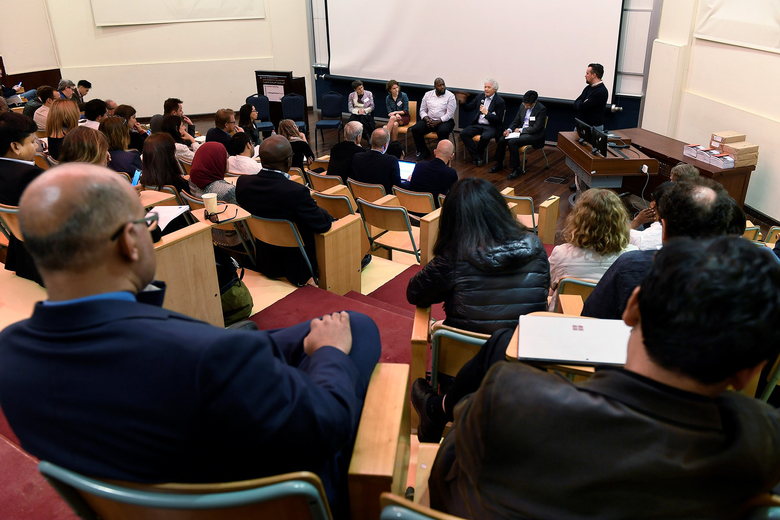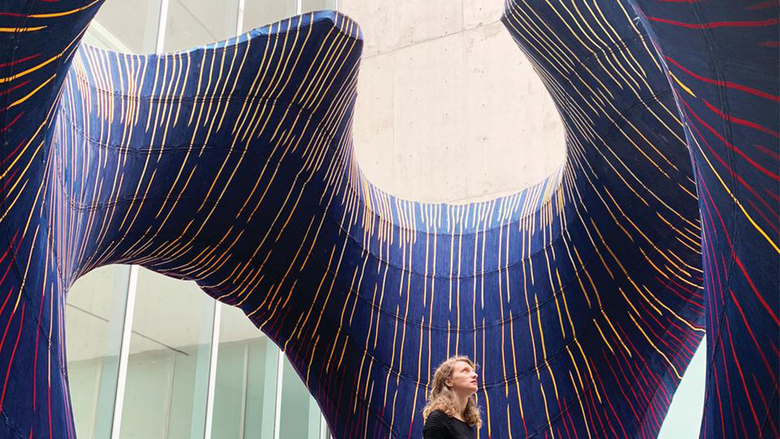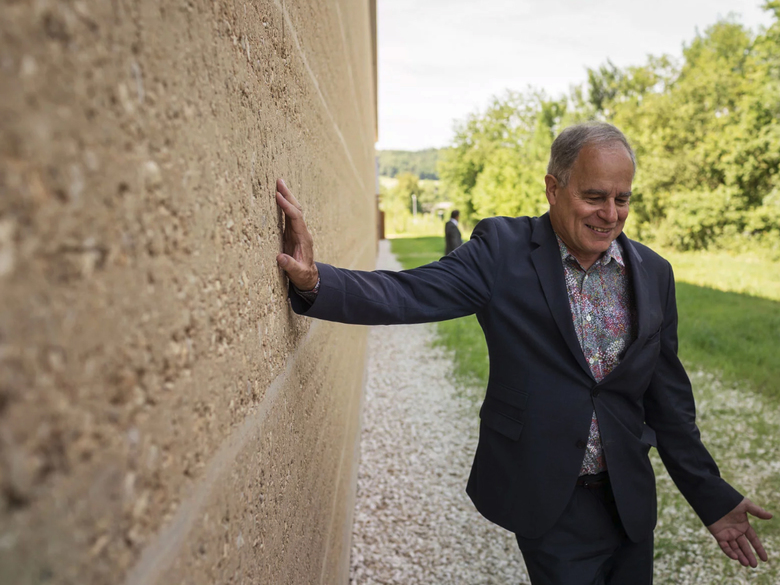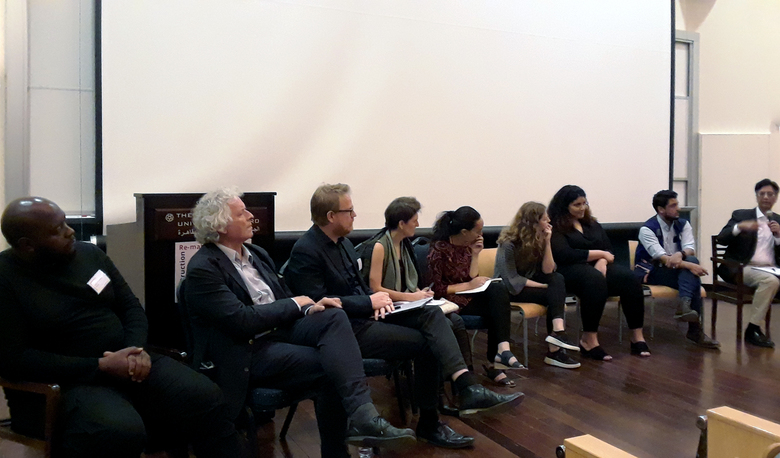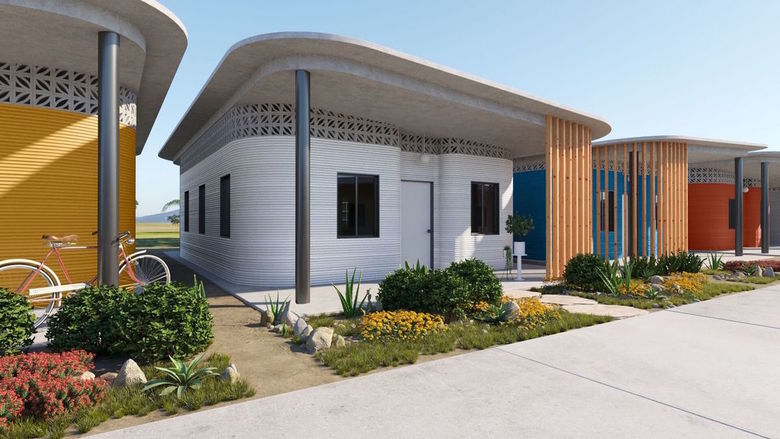"From manual to digital or vice versa," one of the four workshops at the LafargeHolcim Foundation's 6th Forum in Cairo in April, pitted rammed earth and other manual constructions against digital processes. The winner? A hybrid of the manual and digital.
The Forum took place from Thursday, April 4, to Saturday, April 6, with the workshops split into half-day sessions on Thursday afternoon and Saturday morning. Per our first post, keynote addresses took place Thursday morning, mobile workshops happened on Friday, and summary remarks and closing keynotes took place on Friday afternoon. The first day of the "From digital to manual and vice versa" workshop — referred to at the Forum as the Blue Workshop to help designate it from the three other colored workshops — consisted of five presentations that moved back and forth from one end of the workshop's spectrum to the other.
Philippe Block from the Block Research Group (BRG) at ETH Zurich and one of two moderators in the Blue Workshop, presented "Construction Disruption: Rethinking the Floor Slab." Asserting that most of the weight in a building is structure and 50% of a structure's weight is in the floor, BRG's 3D-printed floor system aims to strengthen through geometry by "using material efficiently only where it is needed," thereby reducing the weight of a floor slab. With ribs resembling Gothic vaults, the research project is aesthetically pleasing, but it requires high-tech computational and fabrication equipment to realize and is therefore prohibitive in developing places well beyond Swiss borders.
One solution to technology transfer came from BRG's Mariana Popescu, who presented KnitCandela. The installation was built last year in Mexico with formwork that was digitally fabricated in Zurich and carried thousands of miles in just a handful of suitcases. The flexible formwork was developed as an alternative to heavy and laborious formwork required for concrete construction. Although the thin-shell concrete structure still required some bespoke forms to suspend the fabric formwork, it's hard not to get excited by the colorful result.
On the flip side of BRG were a couple presentations focused on rammed earth. Achilles Ahimbisibwe, a former Transsolar Academy fellow and a Ugandan architect, recounted, among other things, the difficulties he faced in realizing a small rammed earth mockup in his home country. In Uganda, there is one architect for every 200,000 people, deforestation is rampant, and a low skill level permeates the wide self-building culture. Ahimbisibwe, who has worked with MASS Design Group and Sharon Davis Design on projects in other parts of East Africa, has been exploring rammed earth as an alternative to poorly made "country" clay-brick. But the eight-month approval process (!) required to erect a single rammed earth wall mockup clearly illustrates the difficulties faced by proponents of sustainable earth construction; this extends to the fact, asserted by Ahimbisibwe, that many people see rammed earth as a display of poverty and therefore would prefer other, less sustainable materials
Martin Rauch, of Lehm Ton Erde (Loam Clay Earth) in Austria, has devoted his career to rammed earth construction, but he has found a way to deliver it via high-tech means. His company collaborated with Herzog & de Meuron on the Ricola Herb Center that was completed five years ago in Laufen, Switzerland, south of Basel. With labor costs so high in the area, Rauch's firm used an "earth printer" to prefabricate the wall panels in a nearby factory specially built for it and other large-scale projects. The machine (watch it in action) moved back and forth to fill, ram, and dry the earth that was excavated from within a 20km radius of the building site. Like the ETH research projects, the large-scale printer is not a technology that can be exported readily to other countries in need, but it does offer a sustainable alternative to precast concrete in places like Switzerland and Germany — if the building codes allow it.
The second day of the three-day Forum was devoted to mobile workshops — four field trips that ventured into different parts of Cairo, from the pyramids in Giza to the new cities being built in the desert. World-Architects opted for the Giza tour rather than the New Vernacular tour that was part of the Blue Workshop. Therefore I can't really comment on the latter, outside of the fact it looked at informal settlements in brick and concrete (top photo), and that it did not appear to inform the findings presented by Anna Heringer at the close of the Forum.
The second half of the "From digital to manual and vice versa" workshop followed the structure of the first half, with five more presentations and a fairly even split between high-tech and low-tech, digital and manual, 3D-printing and rammed earth. Anna Heringer, UNESCO Chair for Earthen Architecture, Constructive Cultures and Sustainable Development and the other workshop moderator, presented her well-known METI School in Bangladesh and the more recent Bamboo Hostels in China. But it was a small altar for Worms Cathedral in Germany that was most intriguing. The rammed earth altar was designed by Heringer and Martin Rauch in a competition but was made by the parishioners. The process brought harmony to what Heringer called the normally not-so-harmonious community, and it also unintentionally echoed a verse from Exodus that an altar should be made from earth.
Alpha Arsano, from the Sustainable Design Lab at MIT, and Arno Schlueter, from the Institute of Technology in Architecture at ETH Zurich, made separate presentations on reducing energy demand in buildings through high-tech means. Arsano presented a computerized design tool for natural ventilation in houses, while Schlueter discussed the mechanical design of an office building in Singapore that uses water rather than air as a cooling medium. Though both engineering approaches were interesting, the presentation by Alexandria Lafci, co-founder of the social housing nonprofit New Story, was most aligned with the potential of a manual-digital hybrid. Lafci discussed a 3D-printed house that her company has developed with a larger team, what was built as a proof-of-concept house in Austin, Texas, last year. It must have worked well, since last month the team announced the groundbreaking for a 3D-printed community in Latin America. The large Vulcan 3D printer, which can print a house in 48 hours, would do its job on site, like a portable version of Rauch's earth printer. Even though New Story's houses eliminate nearly all construction waste they would be made out of concrete rather than a carbon-neutral material.
With ten presentations addressing the manual-digital theme, it was those by Martin Rauch and Alexandria Lafci that were most promising for a sustainable future. Both use digital fabrication to "print" materials, rammed earth in the first case and concrete in the second. While computerized construction carries with it the specter of job loss, the speed at which they can produce habitable environments is closely aligned with the need for durable housing in many parts of the developing world. A best-case scenario (though not a silver bullet solution for all problems) would combine the on-site robotics of New Story's printer with the zero-carbon output of the Lehm Ton Erde printer: 3D-printed, zero-carbon dwellings for the 90%.
World-Architects travel and accommodations for the LafargeHolcim Forum were made possible by the LafargeHolcim Foundation.

